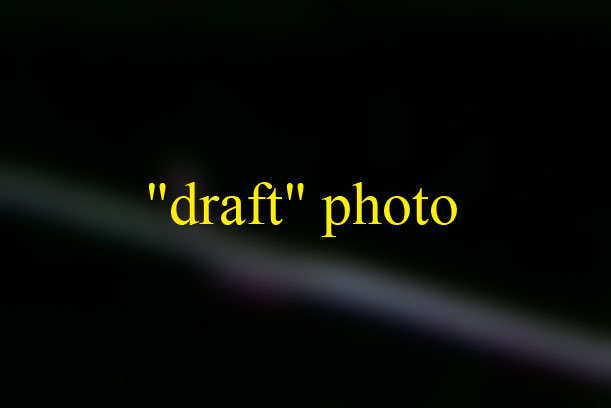|

Wednesday, February 5, 2003
Posted on January 30, 2006
from
WeatherWar Website
recovered through
WayBackMachine Website
Top investigators of the Columbia space
shuttle disaster are analyzing a startling photograph - snapped by
an amateur astronomer from a San Francisco hillside - that appears
to show a purplish electrical bolt striking the craft as it streaked
across the California sky.
The digital image is one of five snapped by the shuttle buff at
roughly 5: 53 a.m. Saturday as sensors on the doomed orbiter began
showing the first indications of trouble.
Seven minutes later, the
craft broke up in flames over Texas.
The photographer requested that his name not
be used and said he would not release the image to the
public until NASA experts had time to examine it.

Peter Goldie, the
individual who took the image of the square lightning strike which
hit Columbia
wishes that I no
longer share this image with the readers of this site until we can
come to a licensing agreement.
This is
understandable. Since his licensing agency does not respond to
requests for permission to use... Here it is.
NASA is just trying to
suppress the truth
above ORIGINAL photo at:
WeatherWars
Website
PhotoBucket
Website
TheLivingMoon Website
AboveTopSecret Website
CloakAndDagger Website
PhotoBucket2 Website
and many more...
Although there are several possible benign explanations for the
image - such as a barely perceptible jiggle of the camera as it took
the time exposure - NASA's zeal to examine the photo demonstrates
the lengths at which the agency is going to tap the resources of
ordinary Americans in solving the puzzle.
Late Tuesday, NASA dispatched former shuttle astronaut
Tammy Jernigan, now a manager at Lawrence Livermore
Laboratories, to the San Francisco home of the astronomer to
examine his digital images and to take the camera itself to Mountain
View, where it was to be transported by a NASA T-38 jet to Houston
this morning.
A Chronicle reporter was present when the astronaut arrived. First
seeing the image on a large computer screen, she had one word:
"Wow."
Jernigan, who is no longer working for NASA, quizzed
the photographer on the aperture of the camera, the direction he
faced and the estimated exposure time - about four to six seconds on
the automatic Nikon 880 camera. It was mounted on a tripod, and the
shutter was triggered manually.
In the critical shot, a glowing purple rope of light corkscrews down
toward the plasma trail, appears to pass behind it, then cuts
sharply toward it from below. As it merges with the plasma trail,
the streak itself brightens for a distance, then fades.
"It certainly appears very
anomalous," said Jernigan. "We sure will be very interested in
taking a very hard look at this."
Jernigan flew five shuttle
missions herself during the 1990s, including three on Columbia. On
her last flight, the pilot of the craft was Rick Husband, who
was at the controls when Columbia perished.
"He was one of the finest people I
could ever hope to know," said Jernigan.
It was an astounding day for the San
Francisco photographer, who said he had not had any success in
reaching NASA through its published telephone hot lines.
He ultimately reached investigators through a connection with a
relative who attends the same church as former astronaut Jack
Lousma, who flew 24 million miles in the Skylab 3 mission in
1973.
Lousma put him in direct touch with Ralph Roe Jr.,
chief engineer for the shuttle program at Johnson Space Flight
Center in Houston.
After a series of telephone conversations Tuesday afternoon, the
photographer had a veteran shuttle mission specialist knocking at
his door by dinnertime.
Within hours, he was left with a receipt,
and his camera was on its way to Houston.
|

